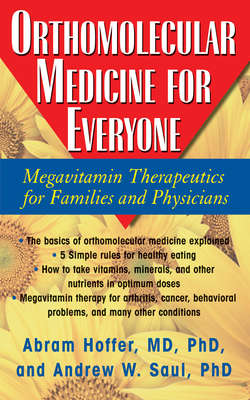Читать книгу Orthomolecular Medicine for Everyone - Abram Hoffer M.D. Ph.D. - Страница 49
Niacin (Vitamin B3)
ОглавлениеMost vitamins were recognized biologically and nutritionally before their chemical structure was determined. In chemistry, compounds are named logically once the structure is finally established. When the first vitamin was purified, it was called vitamin B1 (then later, thiamine). The second one was called vitamin B2 (riboflavin). This was followed by the antipellagra vitamin, B3, later recognized to be nicotinic acid (niacin) and nicotinamide (niacinamide).
Nicotinic acid had been synthesized many years earlier but had remained merely one of a large number of chemicals of no biological interest. Once it was found to be vitamin B3, nicotinic acid was renamed niacin, and nicotinamide was renamed niacinamide for medical use. “Nicotinic acid” was too similar to “nicotine,” an association that suggested the detrimental effects of nicotine and frightened a few away from the vitamin. Both niacinamide and niacin are components of the nucleotide cycle, which ensures the continual production of nicotinamide adenine dinucleotide (NAD). This is the active anti-pellagra factor, a component of the respiratory enzyme system. The designation vitamin B3 was revived by Bill W. (Bill Wilson), a cofounder of Alcoholics Anonymous, when he distributed his first Alcoholics Anonymous report to physicians, which was titled “The Vitamin B3 Therapy.” The term is, in fact, very useful, as it includes both niacin and niacinamide.
The major sources of vitamin B3 are whole-grain cereals, legumes, nuts, and meats. Most cereals have been milled (refined) and their bran and wheat germ stripped away. Since this removes most of their vitamin B3, white wheat flour is “enriched” or reinforced with niacinamide. This was a major factor in eliminating the great pandemic of pellagra that raged in many countries, including the United States, until about 1942, when adding the vitamin was mandated. One hypothesis is that the human race is undergoing an evolutionary change and losing the ability to convert the amino acid tryptophan into niacinamide.1 This makes us more dependent on the supply of the vitamin in our food at the same time that our food provides less of this important nutrient. “Enrichment” quantities are low.
Niacin is needed for the health of the digestive system, skin, and nerves. It is essential for obtaining energy from carbohydrate foods. The body’s complex niacin/niacinamide nucleotide cycle is so important and pervasive that it would take a whole book to describe all its other many remarkable uses and properties. Chief among them are niacin’s participation in the manufacture of sex hormones and in repairing our DNA.
